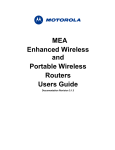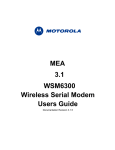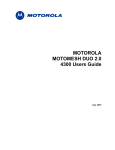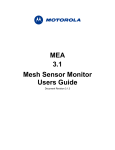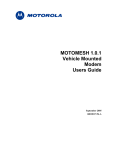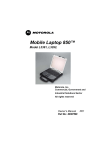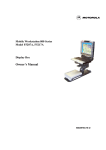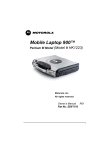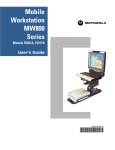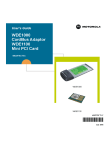Download Motorola WMC6300 Network Card User Manual
Transcript
MEA 3.1 WMC6300 Wireless Modem Card Windows 2000 and XP Users Guide Documentation Revision 3.1.8 Copyrights The Motorola products described in this document may include copyrighted Motorola computer programs. Laws in the United States and other countries reserve for Motorola certain exclusive rights for copyrighted computer programs. Accordingly, any copyrighted Motorola computer programs contained in the Motorola products described in this document may not be copied or reproduced in any manner without the express written permission of Motorola. Furthermore, the purchase of Motorola products shall not be deemed to grant either directly or by implication, estoppels or otherwise, any license under the copyrights, patents or patent applications of Motorola, except for the normal nonexclusive, royalty-free license to use that arises by operation of law in the sale of a product. Disclaimer Please note that certain features, facilities and capabilities described in this document may not be applicable to or licensed for use on a particular system, or may be dependent upon the characteristics of a particular mobile subscriber unit or configuration of certain parameters. Please refer to your Motorola contact for further information. Trademarks Motorola, the Motorola logo, and all other trademarks identified as such herein are trademarks of Motorola, Inc. All other product or service names are the property of their respective owners. Copyrights © 2007 Motorola, Inc. All rights reserved. No part of this document may be reproduced, transmitted, stored in a retrieval system, or translated into any language or computer language, in any form or by any means, without the prior written permission of Motorola, Inc. Table of Contents INTRODUCTION .......................................................................................................................... 1 General System Requirements........................................................................................... 1 Windows XP Minimum Requirements ............................................................................... 1 Windows 2000 Minimum Requirements............................................................................ 2 What’s in the Box................................................................................................................. 2 WMC6300 External Connections and Lights..................................................................... 3 INSTALLING MEA SOFTWARE WITH A WINDOWS XP OPERATING SYSTEM ..................... 4 INSTALLING MEA SOFTWARE WITH A WINDOWS 2000 OPERATING SYSTEM................ 12 INSTALLING THE WMC6300 WIRELESS MODEM CARD ...................................................... 19 Connect the Antenna Assembly....................................................................................... 19 Disconnecting a Pigtail Antenna Assembly .................................................................... 20 Connect the Magnetic Antenna Assembly (Optional) .................................................... 20 Insert the WMC6300 Wireless Modem Card .................................................................... 21 Configuring the DNS Address .......................................................................................... 28 Removing the WMC6300 Wireless Modem Card............................................................. 30 Uninstalling Application Software.................................................................................... 32 OVERVIEW OF MESHTRAY ..................................................................................................... 33 MeshTray ............................................................................................................................ 33 Starting MeshTray.............................................................................................................. 35 MeshTray Status Tab......................................................................................................... 35 MeshTray Configuration Tab ............................................................................................ 36 Geo Position.................................................................................................................... 36 Reporting Interval...................................................................................................................... 36 ii Mesh Enabled Architecture WMC6300 Windows Users Guide Server IP Address..................................................................................................................... 36 Control Channel Configuration ........................................................................................ 37 Changing Control Channel ....................................................................................................... 37 User Priority Settings and Quality of Service Overview .................................................. 38 Classification of Data Packets .................................................................................................. 38 Differentiated Services Code Point........................................................................................... 38 User Priority .............................................................................................................................. 38 Service Differentiation Mechanisms ......................................................................................... 39 Intelligent Access Point Support for Quality of Service ............................................................ 39 Priority Levels for Local Nodes ....................................................................................... 40 Setting the Priority Level for the WMC6300 ............................................................................. 40 Addressing Schemes ...................................................................................................... 42 Network DHCP Addressing Scheme ........................................................................................ 42 Statically Provisioned Addressing Scheme .............................................................................. 43 User Supplied Addressing Scheme .......................................................................................... 43 Setting the User Supplied IP Address ...................................................................................... 43 MeshTray Security Tab...................................................................................................... 47 Allow Open Authentication .............................................................................................. 47 IAP Authentication........................................................................................................... 48 UserId and Password................................................................................................................ 48 Peer Authentication......................................................................................................... 48 MeshTray Authentication Activity Tab............................................................................. 49 MeshTray Geo-Position Tab (Optional) ........................................................................... 50 MeshTray Routing Tab (Optional) .................................................................................... 51 Routing Table.................................................................................................................. 51 Neighbor Table................................................................................................................ 51 Threshold ........................................................................................................................ 51 iii Routing Icons .................................................................................................................. 52 Terminating MeshTray....................................................................................................... 53 TROUBLESHOOTING USING MESHAPI.................................................................................. 54 CUSTOMER SERVICE INFORMATION .................................................................................... 55 Obtaining Support ................................................................... Error! Bookmark not defined. System Information ................................................................. Error! Bookmark not defined. Return Material Request.......................................................... Error! Bookmark not defined. Radio Products and Services Division .................................. Error! Bookmark not defined. Radio Products and Services Division Telephone NumbersError! Bookmark not defined. Returning System Components to Motorola......................... Error! Bookmark not defined. Returning FREs........................................................................ Error! Bookmark not defined. PRODUCT WARRANTY INFORMATION .................................................................................. 58 REGULATORY INFORMATION ................................................................................................ 61 FCC Information................................................................................................................. 61 FCC RF Energy Exposure Statement............................................................................... 61 Regulatory and RF Safety Exposure................................................................................ 61 SAFETY CERTIFICATION ...............................................ERROR! BOOKMARK NOT DEFINED. iv Mesh Enabled Architecture WMC6300 Windows Users Guide List of Figures Figure 1. WMC6300 Wireless Modem Card .................................................................1 Figure 2. WMC6300 Antenna Port and LED Indicators ..............................................3 Figure 3. MEA Setup - Welcome Dialog.......................................................................4 Figure 4. MEA Setup - License Agreement Dialog .....................................................5 Figure 5. MEA Setup – Startup Options Dialog ..........................................................6 Figure 6. MEA Setup - Ready to Install Dialog............................................................6 Figure 7 MEA Setup - Drivers Previously Installed Dialog .......................................7 Figure 8. Confirm Action – Remove Existing Components.......................................7 Figure 9. Removing Programs From Your Computer Window .................................8 Figure 10. Installing Files Window.................................................................................8 Figure 11. Software Installation Dialog Box..................................................................9 Figure 12. Software Installation Dialog Box..................................................................9 Figure 13. Software Installation Dialog Box................................................................10 Figure 14. MEA Setup - mea Installed Successfully Dialog Box ...............................11 Figure 15. MEA Setup - Installer Setup Dialog Box ....................................................12 Figure 16. MEA Setup - License Agreement Dialog Box ..........................................13 Figure 17. MEA Setup – Startup Options Dialog Box.................................................13 Figure 18. MEA Setup - Ready to Install Dialog Box ..................................................14 Figure 19 MEA Setup - Drivers Previously Installed Dialog Box .............................14 Figure 20. Confirm Action – Remove Existing Components.....................................15 Figure 21. Removing Programs From Your Computer Window ...............................15 Figure 22. Installing Files Window...............................................................................16 Figure 23. Digital Signature Not Found Dialog Box ...................................................16 Figure 24. MEA Setup - Select Options Dialog Box ...................................................17 Figure 25. Finished Popup Dialog Box........................................................................18 Figure 26. Attach the Antenna to the WMC6300.........................................................19 v Figure 27. Attach Magnetic Mount Antenna to the WMC6300 ...................................21 Figure 28. Installing the WMC6300 Wireless Modem Card ........................................21 Figure 29. Proper Orientation of Antenna ...................................................................22 Figure 30. Found New Hardware Popup Dialog box ..................................................22 Figure 31. Found New Hardware Wizard – Serial PC Card ........................................23 Figure 32. Found New Hardware Wizard - Loading Files...........................................23 Figure 33. Hardware Installation Dialog Box ..............................................................24 Figure 34. Found New Hardware Wizard - Complete .................................................24 Figure 35. Found New Hardware Wizard – WMC6300 PC Card .................................25 Figure 36. Found New Hardware Wizard Loading Files.............................................25 Figure 37. Hardware Installation Dialog Box - WMC6300 PC Card ...........................26 Figure 38. Found New Hardware Wizard Complete....................................................26 Figure 39. Found New Hardware - Wizard Complete .................................................27 Figure 40. Local Area Connection Properties Dialog Box .........................................28 Figure 41. Unplug or Eject Hardware Icon ..................................................................30 Figure 42. Safe to Remove Hardware - WMC6300 Card .............................................30 Figure 43. Removing the WMC6300 from the PCMCIA slot .......................................31 Figure 44. Confirm Action - Uninstall ..........................................................................32 Figure 45. Removing Programs from Your Computer Dialog Box ...........................32 Figure 46. Inactive MeshTray Icon ...............................................................................33 Figure 47. MeshTray Link Quality Indicator ................................................................33 Figure 48. MeshTray No IP Address Acquired Icon ...................................................34 Figure 49. MeshTray Status Tab ..................................................................................35 Figure 50. MeshTray Configuration Tab......................................................................36 Figure 51. Password Protection Panel ........................................................................37 Figure 52. MeshTray Configuration Tab Priority Settings .........................................40 Figure 53. MeshTray Configuration Tab Addressing Scheme ..................................42 Figure 54. Control Panel – Network and Internet Connections Icon ........................44 Figure 55. Network and Dial-up Connections Window ..............................................44 vi Mesh Enabled Architecture WMC6300 Windows Users Guide Figure 56. Local Area Connection Properties Dialog Box .........................................45 Figure 57. Internet Protocol (TCP/IP) Properties Dialog Box ....................................46 Figure 58. MeshTray Security Tab ...............................................................................47 Figure 59. Peer Authentication – Add..........................................................................48 Figure 60. MeshTray Authentication Activity Tab ......................................................49 Figure 61. MeshTray Geo Position Tab .......................................................................50 Figure 62. MeshTray Geo Position Spherical Coordinates .......................................50 Figure 63. MeshTray Routing Tab................................................................................51 Figure 64. Exit MeshTray ..............................................................................................53 Figure 65. Using EventViewer to Troubleshoot MeshAPI..........................................54 vii Mesh Enabled Architecture WMC6300 Windows Users Guide Introduction Thank you for purchasing the Wireless Modem Card. If you wish to skip this introduction and begin the installation, go directly to the Installing the WMC6300 Wireless Modem Card section of this document. Mesh Enabled Architecture (MEA®) is a wireless communication system capable of supporting high data rate mobile communication at vehicular speeds of up to 250 miles per hour. The MEA system is designed to allow standard client hosts with a PCMCIA interface to have a mobile broadband Ethernet connection. The MEA system works transparently to the client host in a manner similar to an Ethernet connection. MEA provides Internet Protocol based data and location services. Its geo-location accuracy and availability is better than ±10 meters within 1 second. It is capable of supporting subscribers traveling up to 100 miles per hour. Figure 1. WMC6300 Wireless Modem Card The MEA system provides a secure and reliable transport for the client host. The client host may still require configuration and authentication before it will be allowed to access services on the core network. The Network Administrator controls access to the core network. This document provides detailed installation and configuration instructions for installing the MEA WMC6300 Wireless Modem Card and supporting software. General System Requirements Host computers must comply with the following minimum requirements to ensure optimal performance for the WMC6300. Windows XP Minimum Requirements ATTENTION: If you are running Windows XP Service Pack 2 (SP2), Windows Firewall is turned on by default. It is recommended that you disable the firewall when using your WMC6300. • Laptop or Notebook PC running the Microsoft Windows XP (Service Pack 1) operating system • 500 MHz Processor • 10 MB of available hard disk storage 1 • Keyboard, Mouse, CD-ROM drive or DVD drive • Available Type II PCMCIA card slot in the Host device Windows 2000 Minimum Requirements • Laptop or Notebook PC running the Microsoft Windows 2000 (Service Pack 3) operating system • 500 MHz Processor • 10 MB of available hard disk storage • Keyboard, Mouse, CD-ROM drive or DVD drive • Available Type II PCMCIA card slot in the Host device What’s in the Box Each MEA WMC6300 Wireless Modem Card is a full-featured wireless networking interface. The following is a list of the items provided with each WMC6300 card: • MEA WMC6300 Wireless Modem Card • Antenna with a MMCX connector • MEA WMC6300 Software and Documentation CD ROM The MEA CD ROM contains an online version of the MEA WMC6300 User’s Guide in Adobe PDF format. The CD also contains an installation executable to load Adobe Acrobat Reader software if it is not already resident on your computer. 2 Mesh Enabled Architecture WMC6300 Windows Users Guide WMC6300 External Connections and Lights The WMC6300 Wireless Modem Card is designed for insertion into an industry-standard Type II PCMCIA card slot located in a Host device. The WMC6300 has an antenna port to connect the external antenna and two LED Indicators. As shown in Figure 2 the red LED is the transmit indicator and the green LED is the receive indicator. Figure 2. WMC6300 Antenna Port and LED Indicators 3 Installing MEA Software with a Windows XP Operating System ATTENTION: If you are running Windows XP Service Pack 2 (SP2), Windows Firewall is turned on by default. It is recommended that you disable the firewall when using your WMC6300. The following procedure outlines the installation of the MEA software on a typical Windows XP platform. Some of the steps may vary slightly based on the configuration of the individual computers. Complete the following procedure to install the MEA software: 1. Close and exit any existing MEA applications running on the computer prior to installation. 2. Insert the MEA Software and Documentation CD into the CD-ROM drive. 3. If the installation program does not start automatically, open the Windows Start menu. Click on Run then type the following into the dialog box: d:setupmeaclient.exe where d: specifies the CD-ROM drive and click the “OK” button. 4. Click the “Next” button to continue the installation process. 5. The MEA Setup dialog box will be displayed as shown in Figure 3. 6. Click the Next button to continue the installation process. Figure 3. MEA Setup - Welcome Dialog 4 Mesh Enabled Architecture WMC6300 Windows Users Guide 7. The License Agreement dialog box will be displayed as shown in Figure 4. Please review the End User License Agreement. Use the scroll bar located at the right side of the dialog box to display the complete text message. NOTE: If you do not agree with the terms of the license agreement, click on Cancel and the installation will be terminated. 8. To continue with the installation process, select the YES radio button as shown in Figure 4 and then click on the Next button to continue the installation. Figure 4. MEA Setup - License Agreement Dialog 9. The Startup Options dialog box will be displayed as shown in Figure 5. The user can modify the default installation configuration by checking or un-checking the boxes on this installation dialog box. Click on the Next button to continue the installation process. 5 Figure 5. MEA Setup – Startup Options Dialog 10. The Ready to Install dialog box will be displayed as shown in Figure 6. This dialog box displays the Install Folder location and the Shortcut Folder name that will be used to install the MEA software. Click on the Next button to proceed with the installation process. Figure 6. MEA Setup - Ready to Install Dialog 11. If MEA was previously installed on your computer, the Information dialog box will be displayed as shown in Figure 7. Click on the Uninstall button to uninstall the existing 6 Mesh Enabled Architecture WMC6300 Windows Users Guide MEA drivers and continue the installation process. If you do not want to continue, click the Cancel button. Figure 7 MEA Setup - Drivers Previously Installed Dialog 12. The Confirm Action dialog will be displayed. Click on the Yes button to remove all of the previously installed components. If you do not want to continue, click on the No button. Figure 8. Confirm Action – Remove Existing Components 7 13. If you choose to continue with the installation, the Removing Programs From Your Computer dialog will be displayed to indicate the progress of the uninstall operation. When the operation is complete, click on the Close button to dismiss the dialog. Figure 9. Removing Programs From Your Computer Window 14. The Installing Files window will be displayed. It will be dismissed as soon as the installation of the files is complete. Figure 10. Installing Files Window 8 Mesh Enabled Architecture WMC6300 Windows Users Guide 15. The Performing Setup Actions dialog box displays a status bar to indicate the progress of the installation. 16. If the Software Installation dialog box is displayed as shown in Figure 11, it indicates that the software is not Windows Logo tested. Click on the Continue Anyway button to complete the installation process. Figure 11. Software Installation Dialog Box 17. A second Software Installation dialog box is displayed as shown in Figure 12. It indicates the software you are installing is not Windows Logo tested. Click on the Continue Anyway button to complete the installation process. Figure 12. Software Installation Dialog Box 9 18. The Select Options dialog box will be displayed as shown in Figure 13. This dialog box allows the user to view the ReadMe file for the most current release information. It also allows the user to immediately run MeshTray. Click on the Next button to proceed with the installation process. Figure 13. Software Installation Dialog Box 19. If selected, the ReadMe file will be displayed. Review the contents of the file and then dismiss the dialog box by clicking on the X located in the upper right corner of the dialog box. 20. The mea Installed Successfully dialog box will appear as shown in Figure 14. Click on the Finish button to exit. 10 Mesh Enabled Architecture Figure 14. WMC6300 Windows Users Guide MEA Setup - mea Installed Successfully Dialog Box ATTENTION After installing the MEA software, MeshTray must be active when installing the WMC6300 card. 11 Installing MEA Software with a Windows 2000 Operating System The following procedure outlines the installation of the MEA software on a typical Windows 2000 platform. Some of the steps may vary slightly based on the configuration of the individual computers. Complete the following procedure to install the MEA software: 1. Close and exit any existing MEA applications running on the computer prior to installation. 2. Insert the MEA Software and Documentation CD into the CD-ROM drive. 3. If the installation program does not start automatically, open the Windows Start. Click on Run then type the following into the dialog box: d:setupmeaclient.exe where d: specifies the CD-ROM drive and click the “OK” button. 4. The MEA Setup program will be displayed as shown in Figure 15. 5. Click the Next button to continue the installation process. Figure 15. MEA Setup - Installer Setup Dialog Box 6. The License Agreement dialog box will be displayed. Please review the End User License Agreement. Use the scroll bar located at the right side of the dialog box to display the complete text message. 12 Mesh Enabled Architecture WMC6300 Windows Users Guide NOTE: If you do not agree with the terms of the license agreement, click on Cancel and the installation will be terminated. 7. To continue with the installation process, click on the YES button as shown in Figure 16 and then click on the Next button to continue the installation. Figure 16. MEA Setup - License Agreement Dialog Box 8. The Startup Options dialog box will be displayed as shown in Figure 17. The user can modify the default installation configuration by checking or un-checking the boxes on this installation dialog box. Click on Next to continue the installation process. Figure 17. MEA Setup – Startup Options Dialog Box 13 9. The Ready to Install dialog box will be displayed as shown in Figure 18. This dialog box displays the Install Folder location and the Shortcut Folder name that will be used to install the MEA software. Click on Next to proceed with the installation process. Figure 18. MEA Setup - Ready to Install Dialog Box 10. If MEA was previously installed on your computer, the Information dialog box will be displayed as shown in Figure 19. Click on the Next button to uninstall the existing MEA drivers and continue the installation process. If you do not want to continue, press the Cancel button. Figure 19 MEA Setup - Drivers Previously Installed Dialog Box 14 Mesh Enabled Architecture WMC6300 Windows Users Guide 11. The Confirm Action dialog will be displayed. Click on the Yes button to remove all of the previously installed components. If you do not want to continue, click on the No button. Figure 20. Confirm Action – Remove Existing Components 12. If you choose to continue with the installation, the Removing Programs From Your Computer dialog will be displayed to indicate the progress of the uninstall operation. When the operation is complete, click on the Close button to dismiss the dialog. Figure 21. Removing Programs From Your Computer Window 15 13. The Installing Files window will be displayed. It will be dismissed as soon as the installation of the files is complete. Figure 22. Installing Files Window 14. During the installation process, the Performing Setup Actions dialog box displays a status bar that indicates the progress of the installation. 15. If the computer has been configured to check digital signatures, a Digital Signature Not Found dialog box will be displayed as in Figure 23. In response to the query “Do you want to continue the installation?” click on the Yes button. Figure 23. Digital Signature Not Found Dialog Box 16 Mesh Enabled Architecture WMC6300 Windows Users Guide 16. When the file transfer is complete, a dialog box will be displayed as shown in Figure 24 that allows the user to view the ReadMe file for the most current release information. It also allows the user to immediately run MeshTray. Click on Next to proceed with the installation process. Figure 24. MEA Setup - Select Options Dialog Box 17. If selected, the ReadMe file will be displayed. Review the contents of the file and then dismiss the dialog box by clicking on the X located in the upper-right corner of the dialog box. 18. The mea Installed Successfully dialog box will appear as shown in Figure 25. Click on the Finish button to exit. 17 Figure 25. Finished Popup Dialog Box ATTENTION After installing the MEA software, MeshTray must be active when installing the WMC6300 card. 18 Mesh Enabled Architecture WMC6300 Windows Users Guide Installing the WMC6300 Wireless Modem Card ATTENTION After installing the MEA software, MeshTray must be active when installing the WMC6300 card. Connect the Antenna Assembly Complete the following procedure to connect the Antenna Assembly (Knuckle or Pigtail type) to the WMC6300 for use in a standard laptop computer. ATTENTION Always eject card when not in use. Locate the Antenna and insert the connector into the WMC6300 antenna port as shown in Figure 26. NOTE: The connector will snap into place when fully inserted. Figure 26. Attach the Antenna to the WMC6300 ATTENTION Use only FCC approved antennas. Use of another antenna is prohibited and violates FCC regulations. Never use the WMC6300 with the Antenna disconnected from the Card. 19 Disconnecting a Pigtail Antenna Assembly Care should be taken when disconnecting an antenna from the WMC6300 card. Applying force in any direction other than parallel to the card may result in excess pressure being applied to the connection between the WMC6300 connector and the board, which could crack or otherwise damage a solder joint. When disconnecting a pigtail antenna from the WMC6300, additional attention must be taken not to damage the card, connector, or cable. As shown in the following diagram, pull straight out at the connector to avoid damaging the card, connector or cable. Connect the Magnetic Antenna Assembly (Optional) Complete the following procedure to install the Magnetic Mount Antenna on the rooftop of a vehicle. The length of the Antenna cable is approximately 12 feet. 1. Attach the Magnetic Antenna to the metal rooftop of the vehicle so that the antenna is in a vertical orientation. ATTENTION: The base of the antenna contains a powerful magnet that secures the antenna to the rooftop. Use care when attaching the antenna. 2. Route the remaining 12 foot cable as required, to arrive at the Host Computer. ATTENTION When using the WMC6300 in a laptop computer, keep antenna at a minimum separation distance of 20cm from all persons. When using the WMC6300 in a PDA, keep antenna at a minimum separation distance of 1.5cm from all persons. 3. Insert the Antenna Cable Connector into the WMC6300 antenna port as shown in Figure 27. NOTE: The connector will snap into place when fully inserted. 20 Mesh Enabled Architecture Figure 27. WMC6300 Windows Users Guide Attach Magnetic Mount Antenna to the WMC6300 Insert the WMC6300 Wireless Modem Card Complete the following procedure to install the WMC6300 Wireless Modem Card in the computer. 1. Locate an available Type II PCMCIA card slot in the computer. If necessary, remove the slot dust cover from the slot. 2. To insure the correct orientation, insert the WMC6300 Wireless Modem Card into the computer’s PCMCIA card slot with the label side up as shown in Figure 28. ATTENTION: Never force the card into the slot. Figure 28. Installing the WMC6300 Wireless Modem Card 3. The antenna must be attached using the clip and vertically oriented when the laptop is in use as shown in Figure 29. 21 Figure 29. Proper Orientation of Antenna 4. The first time that the card is inserted, a message will be displayed indicating that the PC card has been found as shown in Figure 30. Figure 30. Found New Hardware Popup Dialog box 5. The Windows Found New Hardware Wizard for the Serial PC Card will start as shown in Figure 31. Verify that the “Install the software automatically (Recommended)” radio button is selected, and then click on the Next button. 22 Mesh Enabled Architecture Figure 31. WMC6300 Windows Users Guide Found New Hardware Wizard – Serial PC Card 6. The Found New Hardware dialog will display the progress information for establishing the restore point and backing up old files as shown in Figure 32. As soon as these steps are complete, the Hardware Installation dialog box shown in Figure 33 will be displayed. Click on the Continue Anyway button in the Hardware Installation dialog box. Figure 32. Found New Hardware Wizard - Loading Files 23 Figure 33. Hardware Installation Dialog Box 7. The Found New Hardware Wizard Complete dialog box will appear as shown in Figure 34. Click on the Finish button. Figure 34. Found New Hardware Wizard - Complete 8. An additional Found New Hardware Wizard for the WMC6300 PC Card will be displayed as shown in Figure 35. Verify that the Install the software automatically (Recommended) radio button is selected, and then click on the Next button. 24 Mesh Enabled Architecture Figure 35. WMC6300 Windows Users Guide Found New Hardware Wizard – WMC6300 PC Card 9. A Loading Files dialog box will appear as shown in Figure 36, followed by a Hardware Installation dialog box as shown in Figure 37. Click on the Continue Anyway button in the Hardware Installation dialog box. Figure 36. Found New Hardware Wizard Loading Files 25 Figure 37. Hardware Installation Dialog Box - WMC6300 PC Card 10. The Found New Hardware Wizard Complete dialog box will be displayed as shown in Figure 38. Click on the Finish button. Figure 38. Found New Hardware Wizard Complete 11. The Found New Hardware pop-up window will appear confirming that the driver installation is complete and the hardware is ready to use. 26 Mesh Enabled Architecture Figure 39. WMC6300 Windows Users Guide Found New Hardware - Wizard Complete 27 Configuring the DNS Address Typically, the DNS address will be supplied as part of the WMC6300’s communication with the network. Occasionally however, the Network Administrator must supply the DNS IP address for an Internet connection. This address must be manually configured in order for Internet URLs to be resolved. Complete the following procedure to configure the address: 1. From the windows Start menu, Control Panel 2. On the Control Panel, double-click on the Network and Internet Connections icon then double-click on the Network Connections icon. 3. Right click on the Local Area Connection Corresponding to the Wireless Modem Card and select “Properties” from the pop up menu. Figure 40. Local Area Connection Properties Dialog Box 4. Highlight “Internet Protocol (TCP/IP)” in the Components dialog box as shown in Figure 35. 5. Click on the Properties button. 6. Click on the Advanced button. 28 Mesh Enabled Architecture WMC6300 Windows Users Guide 7. Click on the DNS tab. 8. Click on the DNS Add button. 9. Enter the DNS Server IP Address provided by the Network Administrator and then click the Add button. 10. Click on the OK button to close the Advanced TCP/IP Settings dialog box. 11. Click on the OK button to close the Internet Protocol (TCP/IP) Properties dialog box. 12. Click on the OK button to close the Local Area Connection Properties dialog box. This configuration should remain in the Windows XP host. 29 Removing the WMC6300 Wireless Modem Card The WMC6300 should be ejected using the following procedure to ensure that power to the card is disabled prior to removal. ATTENTION Always eject card when not in use. 1. Click on the Unplug or Eject Hardware icon in the system task bar. Select “Safely remove Generic Multifunction PC-Card” from the popup menu as shown in Figure 41. Figure 41. Unplug or Eject Hardware Icon 2. Wait for a message that indicates that the device may be safely removed from the system as shown in Figure 42. Figure 42. Safe to Remove Hardware - WMC6300 Card 30 Mesh Enabled Architecture WMC6300 Windows Users Guide 3. Eject the WMC6300 from the PCMCIA slot as shown in Figure 43. Figure 43. Removing the WMC6300 from the PCMCIA slot 31 Uninstalling Application Software Complete the following procedure to “Uninstall” the MEA Software: 1. From the Start menu, select Programs→mea→Uninstall mea. NOTE: The MEA software can also be uninstalled using Add/Remove Programs located in the Control Panel. 2. The Confirm Action dialog box will display the query “Are you sure you want to remove ‘mea’ and all of its components?” as shown in Figure 44. Click on Yes to continue. Figure 44. Confirm Action - Uninstall 3. The Removing Programs From Your Computer dialog box will be displayed while the MEA software is uninstalled as shown in Figure 45. When the Uninstalling Software process is complete, click on the Close button. Figure 45. Removing Programs from Your Computer Dialog Box 32 Mesh Enabled Architecture WMC6300 Windows Users Guide Overview of MeshTray MeshTray MeshTray™ is a status and configuration application that reports vital and statistical information about the MEA card. Because MeshTray is a “tray” application, it stays in the desktop system status tray when it is minimized as shown in the following figures. The MeshTray icon changes to indicate both the current mode of operation and the state of the wireless interface. As shown in Figure 46 the MeshTray icon is depicting an inactive or disconnected state. The inactive state applies when a WMC6300 card is not inserted. The disconnected state applies if a card is inserted but is not yet associated with an IAP6300. In a c tiv e M e s h T r a y Ic o n Figure 46. Inactive MeshTray Icon When the WMC6300 is associated with an IAP6300, the MeshTray icon displays the Link Quality to the associated IAP as color-coded bars as shown in Figure 47. The greater the number of bars, the better the Link Quality. A c tiv e M e s h T ra y Ic o n Figure 47. MeshTray Link Quality Indicator 33 The MeshTray icon shown in Figure 48 indicates that the IP address has not yet been acquired from the DHCP server. When this happens, the IP field in the Status Tab displays a flashing or 0 IP (see Figure 49). MeshTray No IP Address Acquired Figure 48. MeshTray No IP Address Acquired Icon 34 Mesh Enabled Architecture WMC6300 Windows Users Guide Starting MeshTray During the software installation process, you can choose to place a MeshTray shortcut icon on the desktop. To start the MeshTray application, double-click on the MeshTray icon or from the Start menu select Programs Æ mea Æ MeshTray.exe. Clicking on the MeshTray icon in the system tray restores the application to a property sheet interface as shown in Figure 44. MeshTray Status Tab When the utility is launched, MeshTray displays useful system information such as a Description of the device, the MAC and IP address of the device, and the Type of device (i.e., Subscriber Device). The Firmware Version and Firmware Build Date displayed here can be used to verify the correct firmware revision is currently loaded on the device, particularly after a firmware upgrade. The associated IAP MAC address and the IAP Link Quality are also displayed. Figure 49. MeshTray Status Tab 35 MeshTray Configuration Tab The Configuration Tab is used to set the parameters for Geo Mode, Channel Mapping, Priority Level, and Addressing Scheme settings. Figure 50. MeshTray Configuration Tab Geo Position If Geo-Position has been enabled on the WMC6300 (check the licensing options for your network devices), the Geo-Position option will be selectable and the user may configure the reporting interval as shown in Figure 50. Otherwise, the Geo-Position box will be grayed out. Reporting Interval If Enhanced Geo has been enabled on the WMC6300, the user will be able to set the reporting interval in seconds for updating the Geo Position data for longitude and latitude or X, Y, Z positions for the Spherical Coordinate option to be displayed on the Geo Position tab. Server IP Address The Server IP Address is the address where the geo position is forwarded or reported to. Typically, this is a centralized server that displays the position of all devices on the network. 36 Mesh Enabled Architecture WMC6300 Windows Users Guide Control Channel Configuration There are four channels available for MEA network communications. The Network Administrator can map the four available Physical channels to three Data channels and one Control channel. The Data channels will be used for data transmission between subscriber devices, infrastructure devices, and the network. The Control channel is designated for internal MEA communication. By default, it is set to the physical channel 3 (2.47 GHz). Changing Control Channel A user should never change the channel mappings unless specifically instructed to do so by the Network Administrator. Clicking on the Change Control Channel button prompts the user to enter the password required to change the control channel configuration. If the user is authorized to change the control channel, the password will be supplied by the Network Administrator. Enter the password and click on the OK button. Figure 51. Password Protection Panel ATTENTION: Any unauthorized change can cause the WMC6300 to stop communication with the network and other subscriber devices. 37 User Priority Settings and Quality of Service Overview Classification of Data Packets The MEA system uses two methods to classify data packets in order to provide them the requested levels of service. The first is the use of the industry-standard Differentiated Services Code Point (DSCP). The second is a proprietary system based on the assigned priority of the node’s user. Differentiated Services Code Point The DSCP is defined in RFC 2474 as a part of the Differentiated Services (DS, or “DiffServ”) field. This field is defined for both the IPv4 and IPv6 headers. The DSCP is a dimensionless number used to index a particular class of traffic and, thereby, a particular transport behavior at each hop. These behaviors are known as Per-Hop Behaviors (PHBs). Some basic code points are defined in RFC 2474 for backwards compatibility with the overlapping “Precedence” field in the IPv4 header, known collectively as Class Selector Code Points. Extensions to these, called Assured Forwarding and Expedited Forwarding classes, are defined in RFCs 2597 and 2598. Other groups of code points are reserved for experimental or site-local use. Most often, the indexed per-hop behaviors are described (and sometimes, implemented) simply in terms of queue prioritization of packets at each hop. However, the behaviors may incorporate other features such as traffic pruning to condition the traffic flowing from the node. For example, voice packets may be assigned a DSCP tag indicating the need for low-latency service. The transport can then intelligently decide to discard stale packets or prioritize new packets to provide the lowest latency possible while, perhaps, sacrificing raw bandwidth or reliability when the demand exceeds capacity. High priority data transfers might be tagged to indicate the need for high reliability. The transport can use this knowledge to increase buffering or provide extra retries, perhaps increasing the stream’s latency but serving the data reliably. Likewise, bulk data packets can be assigned “best effort” service so that the transport layer can intersperse them between packets needing lower latency or higher bandwidth. The MEA system extracts the DS field from IP packets as they enter the wireless mesh, either at the access point or at the subscriber device. The DSCP classification then serves as one of the inputs for selecting an appropriate behavior in the transport mechanisms. User Priority The MEA QoS system also augments the standards-based DSCP traffic classification system with a proprietary feature to implement hierarchical service on a per-user basis. While DSCP can be used to classify the traffic by payload, the User Priority feature classifies traffic by the user that originated it, tagging packets with an assigned priority level. Using this tag, data packets from high priority nodes can be granted preferential service over packets from lower priority nodes. The User Priority at each node is a managed variable with tight control granted to the Network Administrator through the Device Manager utilities available in MeshManager. The user on the WMC6300 node is free to select a priority level through applications using the MeshAPI software interface. However, the Network Administrator through the Device Manager can put bounds on each node, limiting the node’s user priority to a specific range or setting it to a specific value. 38 Mesh Enabled Architecture WMC6300 Windows Users Guide The User Priority feature also underpins a secondary feature known as Emergency Mode. The Emergency Mode feature is also accessed by applications using the MeshAPI and can be used to temporarily grant the user elevated priority for use in emergency situations. However, this ability can also be tightly managed and granted by the Network Administrator through the Device Manager as needed. The current User Priority is assigned to every packet transmitted by the user of the node. This priority tag is preserved in each packet as it passes through the mesh until it reaches the final destination or the wired network Packet classification is based on the current User Priority setting and determines the latency, throughput, and reliability of the transmission of the packet, in both relative and absolute terms. For example, packets of one class may be provided relatively higher throughput in the presence of other lower-class packets, but may also have absolute time-to-live limitations, which will impact the reliability of delivery for packets in the class. A WMC6300 host user’s current priority and maximum allowed priority may be configured within a range of Low (priority level 0) to High (priority level 7). This User Priority feature is unique to the MEA network and only exists between endpoints within the MEA network or between a MEA network node and the entry/exit node on the MEA network. Nodes outside of the MEA Core LAN cannot request a particular priority for transmitted or received traffic. Any traffic into the MEA network needing prioritization must be prioritized at the entry access point or router. Any traffic out of the MEA network will lose its priority assignment at the exit. Service Differentiation Mechanisms The MEA wireless mesh network leverages intelligent and adaptive transport mechanisms in every node in the mesh, including subscriber devices, to provide QoS behaviors. At each hop, the DSCP and User Priority classifications serve as inputs to dictate transport behaviors using these mechanisms. In this way, the mesh nodes cooperate to provide appropriate transport service to packets, even across multiple hops through the mesh Intelligent Access Point Support for Quality of Service The Intelligent Access Point (IAP) queues and shapes traffic as it is relayed into the wireless mesh from the wire, in accordance with the DSCP coding in each packet. As many deployment scenarios have the vast majority of packets entering the mesh at the access points, this mechanism is particularly effective for shaping the traffic in a manner that optimizes the use of bandwidth at what is the main point of contention on most networks. The IAP provides pre-determined QoS levels to its data traffic it. Applications sending data that need prioritized traffic may be configured to set the TOS values in the IP packets at the source/destination devices. IAP support for QoS also provides equal fairness to all traffic within the same precedence class (TOS). Enabling QoS support on an IAP slightly increases priority of best effort UDP traffic over the TCP traffic. The entries in the table below show the minimum guaranteed bandwidth to traffic at various precedence levels. In the absence of traffic at any class, the bandwidth will be distributed amongst other classes, insuring that no bandwidth is wasted. 39 Priority Levels for Local Nodes The User Priority service can be provisioned on a per node basis for use with tiered service and emergency access systems. This priority feature is unique to the MEA network and only exists between endpoints within the MEA network or between a MEA network node and the entry/exit node on the MEA network. Nodes outside of the MEA Core LAN cannot request a particular priority for transmitted or received traffic. Any traffic into the MEA network needing prioritization must be prioritized at the entry access point or router. Any traffic out of the MEA network will lose its priority assignment at the exit. MEA wireless traffic will carry priorities attached to each packet. The MeshAPI can be used to tune the default priority of the local node. The available priority settings are assigned with the Priority Drop-Down box shown in Figure 52. Figure 52. MeshTray Configuration Tab Priority Settings Setting the Priority Level for the WMC6300 Use the Priority drop-down box to select the desired Priority Level. The range is Level_0 to Level_7. The Network Administrator can limit the number of priority levels available for the 40 Mesh Enabled Architecture WMC6300 Windows Users Guide address that will be assigned to the WMC6300. Check with the Network Administrator to determine the overall priority scheme that is currently being observed for your network application and the proper settings to be assigned to your device. There is also an optional Emergency mode for use by special applications. The priority for use in emergency mode is separately provisioned and must be explicitly enabled per node by the Network Administrator. It allows authorized users to override the current priority level assignments and alter the priority levels for packets that need to be assigned the highest priority level for transmission during an emergency situation. 41 Addressing Schemes There are three Host device addressing schemes that allow the Network Administrator increased flexibility in deployment. Figure 53. MeshTray Configuration Tab Addressing Scheme Network DHCP Addressing Scheme Network DCHP requires that the user's host device be configured to request an address from a DHCP server and the inclusion of a DHCP server in the core network configuration to answer these requests. With Network DHCP selected, the network device will forward any DHCP requests to the core network once it becomes associated and establishes communications with the infrastructure. The DHCP server may be configured by the Network Administrator to hand out temporary or static leases. The user must associate and acquire an address from the network before establishing communications. Once a lease has been granted, the address may be dragged out of network coverage for the remainder of the lease or, if a static lease was granted, until the next power cycle. If the lease expires or the user cycles power while outside of network coverage, the user will lose the ability to communicate. This scheme is best for a larger, closely managed network of subscribers who need inside the network coverage and only brief outside of network coverage. 42 Mesh Enabled Architecture WMC6300 Windows Users Guide Statically Provisioned Addressing Scheme Under the Statically Provisioned scheme addresses are configured by the Network Administrator rather than hashed from the MAC address. Host addresses are based on the address programmed into the Transceiver. This scheme does not require a DHCP server on the core network. It should be noted that a DHCP server can still exist on the network to hand out addresses to other nodes using the Network DHCP Scheme as long as the server's address range does not conflict with addresses assigned to devices using the Statically Provisioned or User Supplied Schemes. The IP addresses and options used are configurable per-device by the Network Administrator using MeshManager. The provisioned address may be freely used to communicate while associated or unassociated. The Network Administrator must ensure that the provisioned addresses are routable and do not conflict with any other addresses in use. The Network Administrator is free to provision any option ordinarily provisioned by a DHCP server (subnet mask, DNS, etc.) through programming of the appropriate fields in each device using MeshManager. This scheme is ideal for a managed network of users who regularly need to communicate inside and outside of network coverage or for a network lacking a DHCP server. User Supplied Addressing Scheme Operating under the User Supplied scheme, the user's host device is configured to use a fixed IP address and subnet mask. The user is responsible for configuring options that would otherwise be configured by a DHCP server. It is also up to the user to ensure that the assigned address is routable on the core network (if core network access is needed) and that it does not conflict with other addresses in use. This is analogous to and carries the same caveats as plugging an Ethernet card into a LAN and manually assigning an address to the card. The user is free to communicate while associated or unassociated. This scheme is ideal for small, unmanaged networks lacking a DHCP server. All of these schemes may be assigned per device, either by the user or by the network manager. The network manager can also limit the user-selectable schemes or force a specific scheme. Devices in each of these schemes can interoperate and communicate with each other, so long as the assigned addresses do not conflict and are mutually routable. Setting the User Supplied IP Address To setup the addressing for the User Supplied Scheme, first obtain a valid IP address from your Network Administrator. This is the IP address to be entered in the IP Address box on the Internet Protocol (TCP/IP) Properties dialog General tab. 1. From the Start menu, select Settings Æ Control Panel. Double click on the Network and Dial-up Connections icon. 43 Figure 54. Control Panel – Network and Internet Connections Icon 2. The Network and Internet Connections window will be displayed. Double click on Network and Internet Connections then right click on the Local Area Connection icon and select Properties. Figure 55. Network and Dial-up Connections Window 3. On the Local Area Connection Properties dialog, click to select Internet Protocol (TCP/IP), then click on the Properties button. 44 Mesh Enabled Architecture Figure 56. WMC6300 Windows Users Guide Local Area Connection Properties Dialog Box The Internet Protocol (TCP/IP) Properties dialog box will be displayed. 45 Figure 57. Internet Protocol (TCP/IP) Properties Dialog Box 4. With the Use the following IP address: radio button selected, enter the IP address supplied by the Network Administrator in the IP Address: box. Double click in the Subnet Mask: box to set the default subnet mask. The Default gateway: and the DNS server addresses should have already been set by the Network Administrator. Click on the OK button to accept the changes and dismiss the dialog box. Click the OK button to dismiss the Local Area Connection Properties dialog and the Close button to dismiss the Local Area Connections window. 5. 46 Mesh Enabled Architecture WMC6300 Windows Users Guide MeshTray Security Tab The Security tab is used to set the security password to gain access to the network. Figure 58. MeshTray Security Tab Allow Open Authentication Open Authentication allows authentication of any device currently being monitored and authentication of devices added to the network configuration as they are discovered. When in peer-to-peer mode, click on one of the radio buttons to select the desired authentication option. Local Authentication is based on Peer information. (see Peer Authentication). Force Authorized Allow all clients. Force Unauthorized Deny all clients. 47 IAP Authentication To gain access to the IAP the user must enter a UserId and Password recognized by that IAP. Note: This is only true when IAP is not set to Force Authorized. UserId and Password Enter the appropriate UserId: and Password: to be used for authentication and authorization for network access. Selecting the Remember UserId & Password checkbox allows the encrypted form of the UserId and Password to be written to the registry for future reference. Selecting this option creates a potential weakness in network security since it will allow anyone who has access to the Windows user account to be authenticated. Peer Authentication The Peer Authentication pane displays a table containing the Group Name and Save Pwd stats for all users within a Peer Authorization group. In a Peer-to-Peer network, the user can specify a group name and password to gain access to all other devices associated as peers. The same group name and password must be specified on each node included in the group. Clicking the Add button launches the Add New Group window for the user to add the Group Name and Password. The Remember this Name and Password checkbox provides the option to save the Group Name and Password settings. Figure 59. Peer Authentication – Add Click on the Remove button to remove all group names highlighted in the table. 48 Mesh Enabled Architecture WMC6300 Windows Users Guide MeshTray Authentication Activity Tab The Authentication Activity tab displays Infrastructure (IAP) Activity and Peer-to-Peer (Group) Activity with an associated Time stamp and Count for the number of attempted authentications. The icons displayed in the Time column identify whether attempted authentications were successful ( ) or failed ( ). Figure 60. MeshTray Authentication Activity Tab 49 MeshTray Geo-Position Tab (Optional) If your WMC6300 has been licensed for Geo-Location, an optional tab will be displayed in MeshTray as shown in Figure 61. This tab will display the user’s location in longitude and latitude. Figure 61. MeshTray Geo Position Tab You can also select the Spherical Coordinates checkbox to have the location reported in X, Y, Z coordinates as shown in Figure 62. Figure 62. MeshTray Geo Position Spherical Coordinates 50 Mesh Enabled Architecture WMC6300 Windows Users Guide MeshTray Routing Tab (Optional) If your WMC6300 has been licensed to display routing information, an optional tab will be displayed in MeshTray as shown in Figure 63. Figure 63. MeshTray Routing Tab Routing Table The Routing Table displays the MAC address for the Destination node and the node to be utilized for the Next Hop, the number of Hops to the Destination node and the current State of the link quality to the Destination node. Neighbor Table The Neighbor Table displays the MAC address and the Signal Level for the adjacent nodes that the WMC6300 may route through, depending on the desired end node. The Last Rate column displays the last data rate used to transmit user data to the neighbor destination. If no user data has been sent to the neighbor destination, a data rate of 1.5 is displayed by default. Threshold Adjusting the threshold control allows the user to view neighbors that have a signal level greater than or equal to the selected threshold level. 51 Routing Icons Icon Unknown Description The Unknown icon is a MEA device in the network that is being used to provide a route to another wireless device in the network. The Computer icon represents a Subscriber Device using a MEA WMC6300 Wireless Modem Card in the network. Subscriber Device (SD) Wireless Router IAP The Arrow icon represents a MWR6300 Wireless Router in the MEA network. The MWR6300 is an infrastructure device dedicated to routing data. The Globe icons represent an IAP6300 Intelligent Access Point in the MEA network. A MEA IAP6300 Intelligent Access Point is an infrastructure device that allows access to the wired network. Enhanced Wireless Router The Enhanced Wireless Router (EWR) icon represents either an EWR or a PWR. An EWR//PWR is not a locally attached device and therefore cannot be viewed directly by MeshView. However, MeshView can connect to an EWR/PWR remotely to display its network topology. This functionality requires a remote server to be running on the EWR. Vehicle Mounted Modem The Vehicle Mounted Modem (VMM) icon represents a wireless modem that has been designed for permanent in-vehicle mounting. A VMM is not a locally attached device and therefore cannot be viewed directly by MeshView. However, MeshView can connect to a VMM remotely to display its network topology. This functionality requires a remote server to be running on the VMM. 52 Mesh Enabled Architecture WMC6300 Windows Users Guide Terminating MeshTray To terminate the MeshTray application, follow the steps below: 1. Position the curser over the MeshTray icon that is located in the system status bar. 2. Right-click on the MeshTray icon and select Exit as shown in Figure 64. The task is terminated and the icon is removed until the application is started again from the Start menu. Figure 64. Exit MeshTray 53 Troubleshooting Using MeshAPI When MeshTray is running, MeshAPI reports its status to the system application Event Log. To view your system Event Log: 1. Right-click on the Windows My Computer icon and select Manage. 2. Choose EventViewer→Application. Look for the MeshAPI entries under the Source column. Figure 65. Using EventViewer to Troubleshoot MeshAPI 54 Mesh Enabled Architecture WMC6300 Windows Users Guide Customer Service Information If you have read this document and made every effort to resolve installation or operation issues yourself and still require help, please contact your regional Motorola support representatives USA Motorola System Support Center (SSC) using the following contact information: Phone: 800-221-7144 Hours of Operation: 7 days a week, 24 hours Europe Phone: +44 (0)1793 564680 Email: [email protected] Hours: of Operation: Mon-Fri 09:00 - 17:00 GMT Calls are logged 24 x 7, cases will be worked Mon-Fri 09:00 - 17:00 GMT Asia and Pacific Region Remote Technical Help Desk (Channel Partners) Phone: +63 28 92 79 93 Email: [email protected] Hours of Operation: Mon - Fri 8 am - 6 pm Sat 8 am - 12 noon 55 Obtaining Support Motorola provides technical support services for your system and recommends that you coordinate warranty and repair activities through the Motorola System Support Center (SSC). When you consult the Motorola SSC, you increase the likelihood that problems are rectified in a timely fashion and that warranty requirements are satisfied. Check your contract for specific warranty and service information. System Information To be provided with the best possible opportunity for support, collect the following system information and have it available when obtaining support. (a) Location of the system (b) Date the system was put into service (c) Software or firmware version information for components of your system (d) Serial number(s) of the device(s) or component(s) requiring support (e) A written description of the symptom or observation of the problem: - When did it first appear? - Can it be reproduced? - What is the step-by-step procedure to cause it? (f) Do other circumstances contribute to the problem? For example, changes in weather or other conditions? (g) Maintenance action preceding problem: - Upgrade of software or equipment - Change in the hardware or software configuration - Software reload - from backup or from CD-ROM (note the version and date) Return Material Request After collecting system information, contact the Motorola System Support Center for assistance or to obtain a Return Material Authorization (RMA) number for faulty Field Replaceable Entities (FREs): North America: 800-221-7144 Radio Products and Services Division The Radio Products and Services Division is your source for manuals and replacement parts. 56 Mesh Enabled Architecture WMC6300 Windows Users Guide Radio Products and Services Division Telephone Numbers The telephone numbers for ordering are: (800)-422-4210 (US and Canada orders) The Fax numbers are: (800)-622–6210 (US and Canada orders) The number for help identifying an item or part number is (800)-422-4210; select choice “3” from the menu Returning System Components to Motorola Motorola's service philosophy is based on field replaceable entities (FREs). FREs are system components identified by Motorola to be returned to Motorola for repair. Returning FREs Return faulty FREs to Motorola for repair. When you return an assembly for service, follow these best practices: (h) Place any assembly containing CMOS devices in a static-proof bag or container for shipment. (i) Obtain a return authorization (RA) number from the Motorola System Support Center. (j) Include the warranty, model, kit numbers, and serial numbers on the job ticket, as necessary. (k) If the warranty is out of date, you must have a purchase order. (l) Print the return address clearly, in block letters. (m) Provide a phone number where your repair technician can be reached. (n) Include the contact person's name for return. • Pack the assembly tightly and securely, preferably in its original shipping container 57 Product Warranty Information This warranty applies within the fifty (50) United States, the District of Columbia and Canada. LIMITED WARRANTY MOTOROLA COMMUNICATION PRODUCTS If the affected product is being purchased pursuant to a written Communications System Agreement signed by Motorola, the warranty contained in that written agreement will apply. Otherwise, the following warranty applies. I. WHAT THIS WARRANTY COVERS AND FOR HOW LONG: Motorola Inc. or, if applicable, Motorola Canada Limited ("Motorola") warrants the Motorola manufactured Broadband Data communications product, against material defects in material and workmanship under normal use and service for a period of One (1) Year from the date of shipment. Motorola, at its option, will at no charge either repair the Product (with new or reconditioned parts), replace it with the same or equivalent Product (using new or reconditioned Product), or refund the purchase price of the Product during the warranty period provided purchaser notifies Motorola according to the terms of this warranty. Repaired or replaced Product is warranted for the balance of the original applicable warranty period. All replaced parts of the Product shall become the property of Motorola. This express limited warranty is extended by Motorola to the original end user purchaser purchasing the Product for purposes of leasing or for commercial, industrial, or governmental use only, and is not assignable or transferable to any other party. This is the complete warranty for the Product manufactured by Motorola. Motorola assumes no obligations or liability for additions or modifications to this warranty unless made in writing and signed by an officer of Motorola. Unless made in a separate written agreement between Motorola and the original end user purchaser, Motorola does not warrant the installation, maintenance or service of the Product. Motorola cannot be responsible in any way for any ancillary equipment not furnished by Motorola which is attached to or used in connection with the Product, or for operation of the Product with any ancillary equipment, and all such equipment is expressly excluded from this warranty. Because each system which may use the Product is unique, Motorola disclaims liability for range, coverage, or operation of the system as a whole under this warranty. II. GENERAL PROVISIONS: This warranty sets forth the full extent of Motorola's responsibilities regarding the Product. Repair, replacement or refund of the purchase price, at Motorola's option, is the exclusive remedy. THIS WARRANTY IS GIVEN IN LIEU OF ALL OTHER EXPRESS WARRANTIES. MOTOROLA DISCLAIMS ALL OTHER WARRANTIES OR CONDITIONS, EXPRESS OR IMPLIED, INCLUDING THE IMPLIED WARRANTIES OR CONDITIONS OF MERCHANTABILITY AND FITNESS FOR A PARTICULAR PURPOSE. IN NO EVENT SHALL MOTOROLA BE LIABLE FOR DAMAGES IN EXCESS OF THE PURCHASE PRICE OF THE PRODUCT, FOR ANY LOSS OF USE, LOSS OF TIME, INCONVENIENCE, COMMERCIAL LOSS, LOST PROFITS OR SAVINGS OR OTHER INCIDENTAL, SPECIAL, INDIRECT OR CONSEQUENTIAL DAMAGES ARISING OUT OF THE USE OR INABILITY TO USE SUCH PRODUCT, TO THE FULL EXTENT SUCH MAY BE DISCLAIMED BY LAW. 58 Mesh Enabled Architecture WMC6300 Windows Users Guide III. HOW TO GET WARRANTY SERVICE: Purchaser must notify Motorola's representative or call Motorola's Customer Response Center at 1-800-247-2346 within the applicable warranty period for information regarding warranty service. IV. WHAT THIS WARRANTY DOES NOT COVER: A) Defects or damage resulting from use of the Product in other than its normal and customary manner. B) Defects or damage from misuse, accident, water, or neglect. C) Defects or damage from improper testing, operation, maintenance, installation, alteration, modification, or adjustment. D) Breakage or damage to antennas unless caused directly by defects in material workmanship. E) A Product subjected to unauthorized Product modifications, disassemblies or repairs (including, without limitation, the addition to the Product of non-Motorola supplied equipment) which adversely affect performance of the Product or interfere with Motorola's normal warranty inspection and testing of the Product to verify any warranty claim. F) Product which has had the serial number removed or made illegible. G) Batteries (they carry their own separate limited warranty). H) Freight costs to the repair depot. I) A Product which, due to illegal or unauthorized alteration of the software/firmware in the Product, does not function in accordance with Motorola's published specifications or with the FCC type acceptance labeling in effect for the Product at the time the Product was initially distributed from Motorola. J) Scratches or other cosmetic damage to Product surfaces that does not affect the operation of the Product. K) That the software in the Product will meet the purchaser's requirements or that the operation of the software will be uninterrupted or error-free. L) Normal and customary wear and tear. M) Non-Motorola manufactured equipment unless bearing a Motorola Part Number in the form of an alpha numeric number (i.e., TDE6030B). N) Lift trucks for installation, removal, replacement or repair of the Motorola supplied products from light, power, telephone poles etc. O) Dispatch to remote site locations P) Loading of software upgrades or fixes into the devices. V. GOVERNING LAW In the case of a Product sold in the United States and Canada, this Warranty is governed by the laws of the State of Illinois and the Province of Ontario, respectively. VI. PATENT AND SOFTWARE PROVISIONS: Motorola will defend, at its own expense, any suit brought against the end user purchaser to the extent that it is based on a claim that the Product or its parts infringe a United States patent, and Motorola will pay those costs and damages finally awarded against the end user purchaser in any such suit which are attributable to any such claim, but such defense and payments are conditioned on the following: A) that Motorola will be notified promptly in writing by such purchaser of any notice of such claim; B) that Motorola will have sole control of the defense of such suit and all negotiations for its settlement or compromise; and C) should the Product or its parts become, or in Motorola's opinion be likely to become, the subject of a claim of infringement of a United States patent, that such purchaser will permit Motorola, at its option and expense, either to procure for such purchaser the right to continue using the Product or its parts or to replace or modify the same so that it becomes non-infringing or to grant such purchaser a credit for the Product or its parts as depreciated and accept its 59 return. The depreciation will be an equal amount per year over the lifetime of the Product or its parts as established by Motorola. Motorola will have no liability with respect to any claim of patent infringement which is based upon the combination of the Product or its parts furnished hereunder with software, apparatus or devices not furnished by Motorola, nor will Motorola have any liability for the use of ancillary equipment or software not furnished by Motorola which is attached to or used in connection with the Product. The foregoing states the entire liability of Motorola with respect to infringement of patents by the Product or any its parts thereof. Laws in the United States and other countries preserve for Motorola certain exclusive rights for copyrighted Motorola software such as the exclusive rights to reproduce in copies and distribute copies of such Motorola software. Motorola software may be used in only the Product in which the software was originally embodied and such software in such Product may not be replaced, copied, distributed, modified in any way, or used to produce any derivative thereof. No other use including, without limitation, alteration, modification, reproduction, distribution, or reverse engineering of such Motorola software or exercise of rights in such Motorola software is permitted. No license is granted by implication, estoppel or otherwise under Motorola patent rights or copyrights. 60 Mesh Enabled Architecture WMC6300 Windows Users Guide Regulatory Information FCC Information This device complies with Part 15 of the FCC Rules. Operation is subject to the following two conditions: (1) this device may not cause harmful interference, and (2) this device must accept any interference received; including interference that may cause undesired operation. Federal Communications Commission (FCC) Statement: This Equipment has been tested and found to comply with the limits for a Class B digital device, pursuant to Part 15 of the FCC rules. These limits are designed to provide reasonable protection against harmful interference in an installation. This equipment generates uses and can radiate radio frequency energy and, if not installed and used in accordance with the instructions, may cause harmful interference to radio communications. However, there is no guarantee that interference will not occur in a particular installation. If this equipment does cause harmful interference to radio or television reception, which can be determined by turning the equipment off and on, the user is encouraged to try to correct the interference by one or more of the following measures: • Reorient or relocate the receiving antenna. • Increase the separation between the WMC6300 and radio or television receiver. • Connect the equipment into an outlet on a circuit different from that to which the receiver is connected. • Consult the supplier of the WMC6300 or an experienced radio/TV technician for help. FCC RF Energy Exposure Statement 1. This equipment complies with FCC RF Energy exposure limits set forth for an uncontrolled environment. 2. This Transmitter must not be co-located or operating in conjunction with any other antenna or transmitter. Although this device complies with the FCC RF Exposure limits in multiple configurations of the antenna, we suggest that the antenna be positioned away from the body when transmitting in order to minimize the level of RF Exposure. Regulatory and RF Safety Exposure Your Motorola WMC6300 PCMCIA card is designed and tested to comply with a number of national and international standards and guidelines (listed below) regarding human exposure to RF electromagnetic energy. This product complies with the following RF energy exposure standards and guidelines: • United States Federal Communications Commission, Code of Federal Regulations; 47CFR part 2 sub-part J • American National Standards Institute (ANSI) / Institute of Electrical and Electronic Engineers (IEEE) C95. 1-2005 61 • Institute of Electrical and Electronic Engineers (IEEE) C95.1-1999 Edition • International Commission on Non-Ionizing Radiation Protection (ICNIRP) 1998 • Ministry of Health (Canada) Safety Code 6. Limits of Human Exposure to • Radiofrequency Electromagnetic Fields in the Frequency Range from 3 kHz to 300 GHz, 1999 • Australian Communications Authority Radiocommunications (Electromagnetic Radiation – Human Exposure) Standard, 2003 • ANATEL ANNEX to Resolution No. 303 of July 2, 2002 "Regulation of limitation of exposure to electrical, magnetic and electromagnetic fields in the radio frequency range between 9 KHz and 300 GHz" and "Attachment to resolution # 303 from July 2, 2002" RF Exposure Compliance and Guidelines Operating Instructions To ensure compliance with the general population uncontrolled environment RF exposure limits in these standards, the antenna should be kept at a minimum separation distance of 20cm from all persons when used in a personal or laptop computer. ATTENTION To ensure compliance with FCC requirements, use only Motorola approved, supplied antennas. Use of non-Motorola approved antennas may result in non-compliance with FCC regulations. NOTE: The manufacturer is not responsible for any unauthorized modifications to this equipment. Unauthorized modifications could void user’s authority to operate device. 62








































































